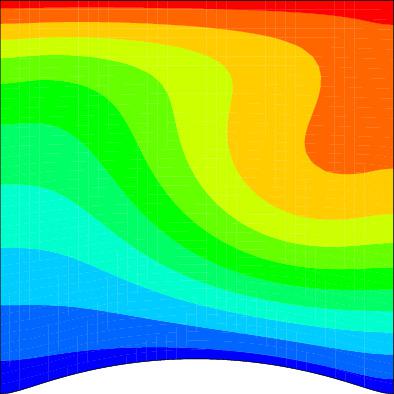当前位置:
X-MOL 学术
›
Int. J. Numer. Methods Fluids
›
论文详情
Our official English website, www.x-mol.net, welcomes your
feedback! (Note: you will need to create a separate account there.)
Extending the cell‐based smoothed finite element method into strongly coupled fluid–thermal–structure interaction
International Journal for Numerical Methods in Fluids ( IF 1.7 ) Pub Date : 2020-10-07 , DOI: 10.1002/fld.4928 Tao He 1
International Journal for Numerical Methods in Fluids ( IF 1.7 ) Pub Date : 2020-10-07 , DOI: 10.1002/fld.4928 Tao He 1
Affiliation

|
This work generalizes the cell‐based smoothed finite element method (CS‐FEM) into fluid–thermal–structure interaction (FTSI) analysis under the arbitrary Lagrangian–Eulerian description. The thermal buoyancy is included with the incompressible Navier–Stokes equations through the Boussinesq approximation. The combined fluid flow and energy equations are solved by a smoothed characteristics‐based split algorithm that incorporates equal low‐order interpolations for the three primitive variables. The structural motions involving both oscillating rigid and flexible bodies are advanced by the generalized‐ method. Moreover, the nonlinear elastodynamics equations discretized with the CS‐FEM are linearized by the modified Newton–Raphson method. An efficient two‐level mesh updating scheme is subsequently discussed to account for large structural displacement and finite solid deformation. The cell‐based smoothing concept is then adopted to evaluate fluid forces acting on the immersed structure. The smoothed FTSI system is iteratively solved by the block‐Gauss–Seidel procedure. Transient FTSI examples are tested to demonstrate the effectiveness and robustness of the CS‐FEM.
中文翻译:

将基于单元的平滑有限元方法扩展为流体-热-结构相互作用的强耦合
在任意拉格朗日-欧拉描述下,这项工作将基于单元的平滑有限元方法(CS-FEM)推广到流体-热-结构相互作用(FTSI)分析中。通过Boussinesq逼近,不可压缩的Navier–Stokes方程包含热浮力。组合的流体流量和能量方程式是通过基于平滑特征的分裂算法求解的,该算法将三个原始变量的等价低阶插值合并在一起。振动的刚体和挠性体的结构运动都通过广义的-方法。此外,通过改进的Newton-Raphson方法将CS-FEM离散化的非线性弹性动力学方程线性化。随后讨论了一种有效的两级网格更新方案,以解决较大的结构位移和有限的实体变形。然后采用基于单元的平滑概念来评估作用在沉浸结构上的流体力。平滑的FTSI系统通过块高斯-赛德尔程序迭代求解。对瞬态FTSI示例进行了测试,以证明CS-FEM的有效性和鲁棒性。
更新日期:2020-10-07
中文翻译:

将基于单元的平滑有限元方法扩展为流体-热-结构相互作用的强耦合
在任意拉格朗日-欧拉描述下,这项工作将基于单元的平滑有限元方法(CS-FEM)推广到流体-热-结构相互作用(FTSI)分析中。通过Boussinesq逼近,不可压缩的Navier–Stokes方程包含热浮力。组合的流体流量和能量方程式是通过基于平滑特征的分裂算法求解的,该算法将三个原始变量的等价低阶插值合并在一起。振动的刚体和挠性体的结构运动都通过广义的-方法。此外,通过改进的Newton-Raphson方法将CS-FEM离散化的非线性弹性动力学方程线性化。随后讨论了一种有效的两级网格更新方案,以解决较大的结构位移和有限的实体变形。然后采用基于单元的平滑概念来评估作用在沉浸结构上的流体力。平滑的FTSI系统通过块高斯-赛德尔程序迭代求解。对瞬态FTSI示例进行了测试,以证明CS-FEM的有效性和鲁棒性。









































 京公网安备 11010802027423号
京公网安备 11010802027423号